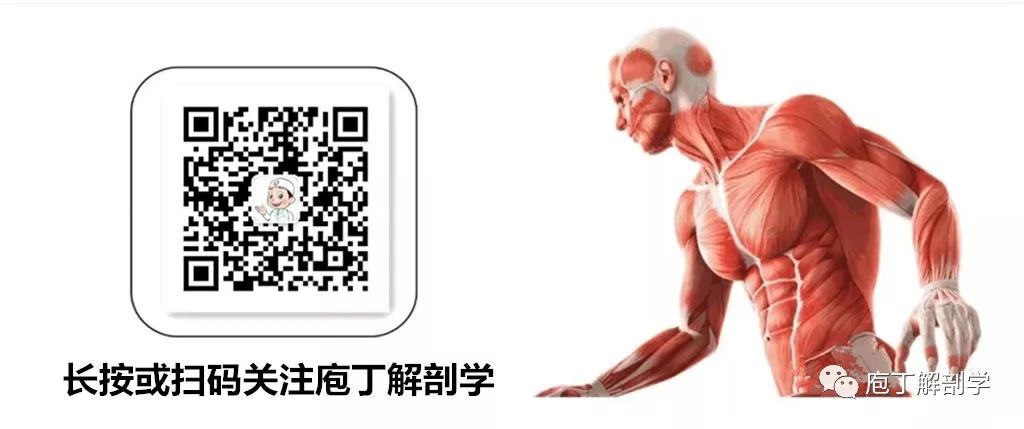A Brief Discussion on the Craft of Medicinal Plaster Production
The external treatment methods in Traditional Chinese Medicine (TCM) include a unique and effective set of therapeutic techniques developed over thousands of years in the fight against diseases.
The plaster therapy has a long history and significant efficacy. Since many diseases enter from the outside, TCM has external treatments to respond accordingly, thus focusing on external applications. Medicinal plasters have various advantages, including portability, ease of use, confirmed efficacy, and high patient acceptance. The early market introduced ointments made from rubber and excipients (such as zinc oxide, petroleum jelly, oil agents, lanolin, etc.) as a base, combined with volatile oils or refined pastes from Chinese herbs. The current predominant production model of medicated plasters has played an important role in promoting the development of traditional TCM plasters.
Medicinal plasters consist of two parts: the base and the medicine. The base is straightforward, while the medicine is more complex, with each individual having their own classic formulations, methods, and combinations. The optimal combination of base and medicine achieves the best results. There are numerous methods for producing medicinal plasters, with various styles continuously innovating and experimenting, and some new dosage forms have emerged by integrating modern techniques, each with its own advantages and disadvantages.
Currently, medicinal plasters can be divided into hard and soft plasters:
1: Traditional Black Plaster: Made by frying with hemp oil and lead powder, it can be distinguished by color (black and white plasters). The production process includes frying materials, refining oil, adding lead powder, collecting the paste, detoxifying, and spreading. Advantages: Traditional black plasters are widely used in clinical practice, have confirmed efficacy, and are highly recognized. Disadvantages: The process is cumbersome, technology is complex, environmental pollution occurs, production is not standardized, the appearance is not consistent, heavy metal content is high, and seasonal production is not easily controlled.
2: Traditional Oil Wax Plaster: Made by boiling hemp oil to extract medicinal oil, then adding white, yellow, and paraffin wax to collect the paste. The production process includes frying materials, refining oil, adding wax, collecting the paste, and spreading. Advantages: Free of heavy metals, easy to control, suitable for learning and use, good shaping properties. Disadvantages: High-temperature refining pollutes the environment, poor adhesion, and instability.
3: Modern Rubber Plaster: Made from zinc oxide, lanolin, and ethanol extraction. The production process includes extracting medicinal substances with ethanol, collecting the base paste, spreading, and cutting.
Advantages: Modern technology, convenient to use, easy to carry. Disadvantages: Small drug load, not reusable, high sensitization rate, complex production equipment.
4: Soft Plaster: Made by mixing medicinal powder with petroleum jelly, honey, and other oily substances. The production process includes grinding powder, adding oily substances, collecting the paste, and using. Advantages: Simple process, easy to produce, flexible use. Disadvantages: Not suitable for fixation, weak adhesion strength, relies on adhesive dressings for fixation.
5: Powdered Formulation: Made by placing medicinal powder in powder bags. The production process includes grinding powder and bagging. Advantages: Simple production, not prone to contamination, no residue on the skin, aesthetically pleasing, flexible use, and convenient (for better effect, sprinkle a permeating agent on the powder before use). Disadvantages: Powder bags should not directly contact the skin, large amount of raw herbs affects medicinal efficacy, relies on adhesive dressings for fixation.
6: Rosin Plaster: Made by boiling rosin and camphor, then adding medicinal powder to collect the paste. The production process includes adding materials, melting, adding medicine, collecting the paste, and spreading. Advantages: Simple production, easy to control, low-temperature boiling, easy to peel off, good shaping properties, lead-free. Disadvantages: Multiple grades of rosin, flammable at high temperatures, seasonal production.
7: Hot Melt Plaster: Made by melting hot melt adhesive and water-soluble adhesive, then adding raw medicinal materials for spreading. The production process includes adding materials, melting, adding medicine, spreading, and cutting. Advantages: Convenient production, good peeling strength, strong adhesion, quick shaping, does not slide off. Disadvantages: Poor absorption, low permeability, high sensitization rate, poor stability (hot melt adhesive is now used in the combination of plaster base and adhesive dressings, but the sensitization rate is still not well controlled, while water-soluble adhesive has stable performance but high production costs).
8: Glutinous Wood Fiber Plaster: Made by mixing wood fiber as the base with medicinal materials. The production process includes adding wood fiber, adding medicine, mixing, and collecting the paste. Advantages: Room temperature production, simple process, maximum drug load, no pollution, no irritation, does not stain clothing, no seasonal production. Disadvantages: Low peeling strength, low adhesion, should be used with adhesive dressings.
1. Five Tiger Bi Syndrome Plaster
1. Composition of Medicinal Ingredients
Group A: Sheng Ma Qian Zi (Strychnos nux-vomica) 60 g, Sheng Chuan Wu (Aconitum carmichaelii) 30 g, Sheng Cao Wu (Aconitum kusnezoffii) 30 g, Sheng Nan Xing (Arisaema cumingii) 30 g, Sheng Ban Xia (Pinellia ternata) 30 g, Dang Gui (Angelica sinensis) 30 g, Wu Jia Pi (Acanthopanax gracilistylus) 30 g, Tou Gu Cao (Hedyotis diffusa) 30 g, Rou Gui (Cinnamon) 30 g, Chuan Xiong (Ligusticum chuanxiong) 45 g, Xi Xin (Asarum sieboldii) 15 g, Gan Jiang (Zingiber officinale) 30 g, Hong Hua (Carthamus tinctorius) 30 g, Du Zhong (Eucommia ulmoides) 30 g, Bing Pian (Borneol) 30 g, Indomethacin Tablets 25 mg x 80 tablets, Diphenhydramine Tablets 25 mg x 40 tablets.
Group B: Rosin 720 g (1.5 times the amount of Group A medicinal powder), Camphor 144 g in summer (20% of rosin amount), 158 g in winter (22% of rosin amount), Vaseline 43 g (6% of rosin amount), Far Infrared Ceramic Powder 72 g (10% of rosin amount), “New Me” Nitrogen 29 mL (4% of rosin amount).
2. Production Method
Grind the above Group A medicinal ingredients into fine powder, sieve through an 80-100 mesh sieve, weigh and mix evenly, and seal for later use. Crush the rosin into coarse powder and place it in an iron pot or electric pot, heating it over low heat until completely melted, then add camphor and Vaseline, stirring until fully melted, and then add the mixed Group A medicinal powder, finally adding far infrared ceramic powder and nitrogen, stirring until completely mixed before spreading the paste to make 40 g per patch of Five Tiger Bi Syndrome Plaster, bagging and sealing, and storing in a cool place.
3. Indications
Neck, shoulder, waist, and leg pain.
4. Treatment Effects
For cervical spondylosis in 20 patients, 12 were cured, 6 improved, and 2 were ineffective.
For shoulder periarthritis in 19 patients, 12 were cured, 5 improved, and 2 were ineffective.
For lumbar spondylosis in 23 patients, 7 were cured, 14 improved, and 2 were ineffective.
For osteoarthritis in 28 patients, 18 were cured, 8 improved, and 2 were ineffective.
For calcaneal bone hyperplasia in 38 patients, 34 were cured, 3 improved, and 1 was ineffective.
For tennis elbow in 20 patients, 14 were cured, 3 improved, and 3 were ineffective.
For soft tissue injuries in 40 patients, 32 were cured, 7 improved, and 1 was ineffective.
5. Precautions
1. During medication, it can be used in conjunction with traction, acupuncture, and massage methods.
2. Avoid eating raw, cold, and greasy foods.
3. Not suitable for pregnant women.
2. Fast-Acting Black Plaster (for Pain Relief)
1. Composition of Medicinal Ingredients
Sheng Chuan Wu 10 g, Sheng Cao Wu 10 g, Scorpion 10 g, Centipede 10 g, Frankincense 10 g, Myrrh 10 g, Hong Hua 10 g, Xue Jie (Dragon’s Blood) 10 g, Pangolin 10 g, Tou Gu Cao 10 g.
2. Production Method
Sesame oil 4 taels, Tung oil 3 taels, Cottonseed oil 3 taels, Yellow lead 4 taels. Heat sesame oil, Tung oil, and cottonseed oil in a pot to 40-80 degrees, then add Sheng Chuan Wu, Sheng Cao Wu, Scorpion, Centipede, Hong Hua, Pangolin, and Tou Gu Cao to the oil and simmer until the surface of the medicine turns dark brown and the inside is yellow, at about 200-250 degrees, then remove from heat, cool, and filter. Then return the medicinal oil to the pot, first on low heat and then on high heat while stirring continuously. This process is crucial for making the plaster, as the proper oil heating determines the quality of the plaster. If the oil is not heated enough, the plaster will be loose and cannot adhere to the affected area when heated. If the oil is overheated, not only will the yield be low, but the plaster will also be hard, with weak adhesion, making it easy to fall off or become waste. The right heating is indicated by water droplets forming beads. Once this occurs, immediately remove the pot from heat, and when the oil cools to 200-250 degrees, add yellow lead while stirring continuously for about 5-10 minutes. After adding the lead, perform a tenderness test after about 3-5 minutes, and once ready, remove from heat, then add Frankincense, Myrrh, and Xue Jie in fine powder, mixing well. The plaster can then be poured into prepared cold water and soaked for 3-7 days, changing the water 1-2 times daily to remove fire toxins.
During production, the detoxified plaster can also be heated and melted in the pot. Stir well, then mix in the fine materials and stir evenly before spreading and storing.
3. Indications
Fractures, postoperative sprains and strains, and labor injuries. Effective for pain caused by invasion of wind, cold, and dampness, such as neck, shoulder, waist, leg, and joint pain, as well as rheumatism and rheumatoid arthritis.
4. New Method Modification
Sheng Chuan Wu and Sheng Cao Wu each 50 g, Quan Chong 30 g, Centipede 30 g, Frankincense and Myrrh each 45 g, Hong Hua 45 g, Xue Jie 30 g, Pao Shan Jia 45 g, Tou Gu Cao 60 g, base 1200 g.
Production Method: Grind the above medicines into powder and mix with the base to form a paste for later use.
3. Bone Spirit Plaster
1. Composition of Medicinal Ingredients
Xi Xin 10 g, Xu Chang Qing 20 g, Sheng Chuan Wu 10 g, Mu Guo 20 g, Tou Gu Cao 20 g, Hong Hua 15 g, Frankincense 10 g, Tu Yuan 10 g, Zhi Zi 10 g, Ling Xian 10 g, Sheng Da Huang 5 g, Chi Shao 15 g, Hong Teng 10 g, Bing Pian 5 g, Ma You 240 g, Rosin 120 g.
2. Production Method
Heat Ma You to 40-80 degrees, add Rosin and simmer until water droplets form beads, then remove from heat and cool to 240-260 degrees, add Frankincense to melt, then remove from heat and cool to 70 degrees, add the medicinal powder and stir, and when the temperature drops to 40 degrees, add Bing Pian.
3. Indications
Activates blood circulation, reduces swelling, and relieves pain. Suitable for bone hyperplasia, lumbar disc herniation, avascular necrosis of the femoral head, shoulder periarthritis, lumbar muscle strain, and sciatica.
4. New Method Modification
Grind the above medicines into powder and mix with the base to form a paste for later use.
4. Bone Spur Plaster
1. Composition of Medicinal Ingredients
Sapindus 300 g.
2. Production Method
Grind into fine powder and mix with 1000 g of base, then collect the paste for later use.
3. Indications
Treats bone hyperplasia in the cervical, thoracic, lumbar spine, heel, knee joints, and fingers.
4. Precautions
This plaster can eliminate local pain after two applications, but an additional application is needed to consolidate the effect.
5. Cervical Spondylosis Plaster (Blood Activating and Pain Relieving Plaster)
1. Composition of Medicinal Ingredients
A: Sheng Chuan Wu 60 g, Sheng Cao Wu 60 g, Xi Xin 40 g, Bai Jie Zi 40 g, Hua Jiao 40 g, Pao Shan Jia 40 g, Chen Xiang 40 g, Frankincense 50 g, Myrrh 50 g, Ci Shi 50 g.
B: Hong Hua 60 g, Zhen Jiao 60 g, Du Huo 60 g, Chuan Xiong 60 g, Dang Gui 60 g, Shen Jin Cao 60 g, Gong Ying 60 g, Tou Gu Cao 60 g, Ling Xian 120 g, Qiang Huo 20 g. Ma You 1000 g, Lead Powder 500 g (base).
2. Production Method
Grind into fine powder and mix with the base for later use.
3. Treatment Range
Cervical spondylosis.
6. Lumbar Disc Herniation Plaster
1. Composition of Medicinal Ingredients
Frankincense 120 g, Myrrh 120 g, Ma Huang 100 g, Sheng Ma Qian Zi 60 g, Sheng Chuan Wu and Sheng Cao Wu each 60 g, Guo Sui Bu 200 g, Zi Ran Tong 100 g, Sheng Du Zhong 120 g, Di Long 300 g, Xue Jie 120 g, Huang Lian 120 g, Guang Dan 1500 g, Xiang You 3 Kg.
2. Production Method
Grind into fine powder and mix with the base for later use.
3. Treatment Range
Lumbar disc herniation.
7. Bone Recovery Plaster
1. Composition of Medicinal Ingredients
A: Sheng Nan Xing 100 g, Tu Bie Chong 50 g, Sheng Ban Xia 100 g, Sheng Ma Qian Zi 50 g, Zhi Ru Mei, Ai Wei, Rou Gui, Pao Xin each 30 g.
B: Dang Gui, Du Huo, Sheng Chuan Wu, Sheng Cao Wu, Zhi Bai Fu Zi, Qian Nian Jian, Chuan Niu Xi each 50 g.
2. Production Method
Grind into fine powder, add to 3500 g of black plaster (base), melt, and spread (15 × 15 cm), change the medicine once every 7 days.
3. Treatment Range
Avascular necrosis of the femoral head.
8. Pine Camphor Ling Xian Plaster
1. Composition of Medicinal Ingredients
A: Sheng Ma Qian Zi 60 g, Sheng Chuan Wu 75 g, Sheng Cao Wu 60 g, Sheng Nan Xing 60 g, Sheng Ban Xia 60 g, Gu Yue 30 g, Qing Quan Chong 30 g, Rou Gui 30 g, Qi Chong 30 g, Sheng Bai Jie Zi 30 g, Yang Jin Hua 45 g, Gan Sui 30 g, Tu Chong 50 g, Xue Xie 30 g, Sheng Frankincense 45 g, Sheng Myrrh 45 g, San Qi Powder 30 g, Pao Shan Jia 30 g, (Liao) Xi Xin 45 g, Qi Ye Yi Zhi Hua 45 g, Bing Pian 15 g, Pu Er Shen 100 tablets, Yan Tong Xi Kang 150 tablets, totaling 875 g (Pu Er Shen and Yan Tong Xi Kang are not measured).
B: Chan Su 25 g, Wu She 60 g, Gui Zhi 90 g, Sang Zhi 90 g, Sheng Ma Huang 60 g, Fang Yi 30 g, Qin Jiao 45 g, Sheng Tao Ren 60 g (crushed), Hong Hua 45 g, Fang Feng 45 g, Cang Zhu 30 g, Ji Xue Teng 90 g, Dang Gui 60 g, Bai Zhi 60 g, Qiang Du Huo each 45 g, Ji Suan 60 g (crushed), Su Mu 50 g, Guang Long 45 g, Wei Ling Xian 60 g, Pian Jiang Huang 50 g, Niu Xi 50 g, Mu Guo 45 g, Sheng Xiang Fu 60 g, Chuan Xiong 45 g, Ling Zhi 60 g, Tou Gu Cao 75 g, San Leng 60 g, Wen Zhu 60 g, Chuan Shan Long 90 g, Jiang 60 g, Lu Han Cao 60 g, Xun Gu Feng 60 g, totaling 1879 g (after drying, about 50 g).
2. Production Method
(1) For Group A, grind Sheng Ma Qian Zi to Yan Tong Xi Kang, and pass through an 80-100 mesh sieve, weigh and mix evenly for later use.
(2) For Group B, Wu She to Xun Gu Feng, decoct twice, each time for more than one hour, mix the two decoctions, filter, weigh the plaster base 3200 g, melt over low heat, remove from heat, cool to 70 degrees, and slowly add the liquid extract while stirring until fully mixed. Continue heating over low heat to evaporate moisture, then remove from heat, cool to 70 degrees, and add Group A, stirring evenly before spreading the plaster.
The above materials can produce 120 patches of Ling Xian Plaster, each weighing 45 g. Store the finished plaster in bags in a cool place.
3. Indications
Neck, shoulder, waist, leg pain, bone hyperplasia, rheumatism, avascular necrosis of the femoral head, acute sprains and strains.
4. Usage Method
The Pine Camphor Ling Xian Plaster is a white plaster made from rosin and Xian Shi powder as the base material. Before applying, cut off the four corners of the plaster, remove the plastic film from the medicinal side, and apply it directly to the affected area, pressing down for a moment after application.
5. Precautions
1. If itching or small red rashes occur after application, it is due to the medicinal power penetrating the lesion and irritating the skin. If itching is severe, temporarily remove the plaster and gently wipe with a warm towel, do not scratch with hands, and wait until the itching subsides before reapplying.
2. Do not apply to open wounds or various skin diseases.
3. Pregnant women should avoid applying to the waist and abdomen.
4. Store in a cool, dry place, sealed.
9. Swelling Relief No. 2 Plaster
1. Composition of Medicinal Ingredients
Sheng Zhi Zi 90 g, Bai Zhi 30 g, Sheng Ban Xia, Sheng Cao Wu, Xi Xin, Zhi Ru Mei, Hong Hua, Dang Gui Wei each 9 g.
2. Production Method
Grind into fine powder, mix with the base to form a paste.
3. Indications
Acute contusions and sprains.
10. Bone Immortal Plaster
1. Composition of Medicinal Ingredients
A: Sheng Ma Qian Zi 60 g, Sheng Chuan Wu and Sheng Cao Wu each 50 g, Sheng Nan Xing 50 g, Sheng Ban Xia 50 g, Gan Sui 30 g, Tu Chong 50 g, Qi Ye Yi Zhi Hua 50 g, Yang Jin Hua 50 g, Sheng Bai Jie Zi 30 g, San Qi Powder 30 g, Myrrh 45 g, Xue Jie 30 g, Rou Gui 30 g, Xi Xin 45 g, Bing Pian 20 g, Camphor 50 g, She Xiang 1.0 g (optional), Pao Shan Jia 45 g, Centipede 30 g, Quan Chong 30 g, Sheng Yan Hu 60 g, Yu Jin 60 g, Pu Er Shen 100 tablets, Yan Tong Xi Kang 150 tablets.
All the above medicines should be ground into fine powder (about 100 mesh), weighed, and mixed evenly.
B: Wu She 60 g, Ling Xian 90 g, Ma Huang 60 g, Gui Zhi 90 g, Ji Xue Teng 90 g, Tao Ren 45 g, Hong Hua 45 g, Dang Gui 45 g, Chuan Xiong 50 g, Sheng Di 50 g, Qiang Huo 40 g, Da Huo 40 g, Qin Jiao 45 g, Fang Feng 30 g, Di Long 45 g, Tou Gu Cao 50 g, Cang Zhu 30 g, San Leng 60 g, E Zhu 60 g, Dan Shen 50 g, Zhi Qiao 40 g, Niu Xi 50 g, Mu Guo 45 g, Shen Jin Cao 50 g, Lu Han Cao 90 g, Hai Feng Teng 60 g, Xun Gu Feng 60 g, Shen Jiang 60 g, Shan Nai 60 g, Gan Jiang 120 g, Su Mu 60 g, Sang Zhi 60 g, Chuan Shan Long 60 g.
2. Production Method
B is decocted twice, each time for more than one hour, the two decoctions are mixed and filtered, weigh the plaster base 3200 g, melt over low heat, remove from heat, cool to 70 degrees, and slowly add the liquid extract while stirring until fully mixed. Continue heating over low heat to evaporate moisture, then remove from heat, cool to 70 degrees, and add A, stirring evenly before spreading the plaster.
The above materials can produce 120 patches of Bone Immortal Plaster, each weighing 45 g. Store the finished plaster in bags in a cool place.
3. Indications
Neck, shoulder, waist, leg pain, bone hyperplasia, acute sprains and strains, rheumatism, avascular necrosis of the femoral head.
4. Usage Method
The Bone Immortal Plaster is a black plaster made from various medicinal ingredients. Before applying, cut off the four corners of the plaster, remove the plastic film from the medicinal side, and apply it directly to the affected area, pressing down for a moment after application.
5. Precautions
1. If itching or small red rashes occur after application, it is due to the medicinal power penetrating the lesion and irritating the skin. If itching is severe, temporarily remove the plaster and gently wipe with a warm towel, do not scratch with hands, and wait until the itching subsides before reapplying.
2. Do not apply to open wounds or various skin diseases.
3. Pregnant women should avoid applying to the waist and abdomen.
4. Store in a cool, dry place, sealed.
【Thirteen】 Song’s Plaster for Treating Neck, Shoulder, Waist, and Leg Pain
1. Composition of Medicinal Ingredients
Dang Gui, Chi Shao, Chen Pi, Ma Huang, Bai Jie Zi, Shan Mei, Jiang Ban Xia, Zhi Ru Mei, Zhi Mei, Sheng Jiao, Chuan Duan, Su Mu, Bai Zhi, Rou Gui, Jiang Can, Guang Mu Xiang, Tou Gu Cao each 12 g, Chuan Duan 9 g, Su Mu, Bai Zhi, Rou Gui, Jiang Can, Guang Mu Xiang, Tou Gu Cao each 7 g, Sheng Nan Xing, Pu Xiao, Shang Lu Gen each 21 g, Sheng Da Huang 27 g, Ma You 1000 g, Rosin 400 g.
2. Production Method
Use traditional plaster-making methods to produce the plaster for external application.
3. Treatment Effects
Pain relief is noticeable within 30 minutes after application, with significant efficacy.
4. Indications
Treats neck, shoulder, waist, and leg pain.
【Fourteen】 External Medicinal Formula for Treating Neck, Shoulder, Waist, and Leg Pain
1. Composition of Medicinal Ingredients
Sheng Chuan Wu, Sheng Cao Wu, Chuan Xiong, Dang Gui, Hong Hua, Du Zhong, Xu Duan, Sang Ji Sheng, Ling Xian, Shen Jin Cao, Gui Zhi, Qin Jiao, Du Huo, Cang Zhu, Ji Xue Teng each 30 g, Xi Xin, Sheng Ma Qian Zi each 20 g.
2. Production Method
Grind into powder, moisten with vinegar for external application, or soak in wine for external rubbing.
3. Treatment Effects
This is an external medicinal formula by Professor Zhou from Henan University of Traditional Chinese Medicine, with particularly good effects.
4. Indications
Treats neck, shoulder, waist, and leg pain.
【Fifteen】 External Application Formula for Treating Neck, Shoulder, Waist, and Leg Pain
1. Composition of Medicinal Ingredients
Ling Xian, Tou Gu Cao, Nan Xing, Chuan Wu, Cao Wu, Xi Xin, Ma Qian Zi, Yang Jin Hua, She Chuang Zi each 200 g, Frankincense, Myrrh each 150 g, Bai Jie Zi 800 g, ground into fine powder.
2. Production Method
Take an appropriate amount each time, mix with cool water to form a paste for external application for one hour, normal to feel warmth. Use once every three days.
3. Indications
Effective for rheumatic arthritis, shoulder periarthritis, and other conditions caused by wind, cold, and dampness, with immediate effects.
【Sixteen】 Stretching and Pain Relief Powder
1. Composition of Medicinal Ingredients
Sheng Chuan Cao Wu 10 g, Sheng Ban Xia 10 g, Myrrh 12 g, Frankincense 10 g, Er Cha 12 g, Zhi Ma Qian Zi 15 g, Tou Gu Cao 15 g, Shen Jin Cao 15 g, San Qi 6 g, Ma Huang 15 g.
2. Production Method
Grind into powder, mix with vinegar for external application, and apply infrared radiation.
3. Indications
For lumbar hyperplasia, cervical hyperplasia, bone spurs, and pain caused by wind, cold, and dampness.
【Seventeen】 Lumbar Disc Herniation Plaster
1. Composition of Medicinal Ingredients
Sheng Frankincense 60 g, Sheng Myrrh 60 g, Ma Huang 50 g, Sheng Ma Qian Zi 30 g, Sheng Chuan Wu, Sheng Cao Wu each 30 g, Guo Sui Bu 100 g, Zi Ran Tong 50 g, Sheng Du Zhong 60 g, Di Long 150 g, Ling Xian 30 g, Xue Jie 60 g, Huang Lian 60 g, Ai Ye 15 g, Fan Xie Ye 40 g, Camphor, Bing Pian each 20 g.
2. Production Method
Soak the total amount of medicinal ingredients in three times the amount of sesame oil for 7 days, then process the highlighted ingredients into 120 mesh fine powder, fry to extract, and add the lead to form a paste, then add the medicinal powder to complete!
3. Indications
Lumbar disc herniation.
4. Treatment Effects
This formula has been used in clinical practice for many years, specifically for lumbar disc herniation, with excellent efficacy!
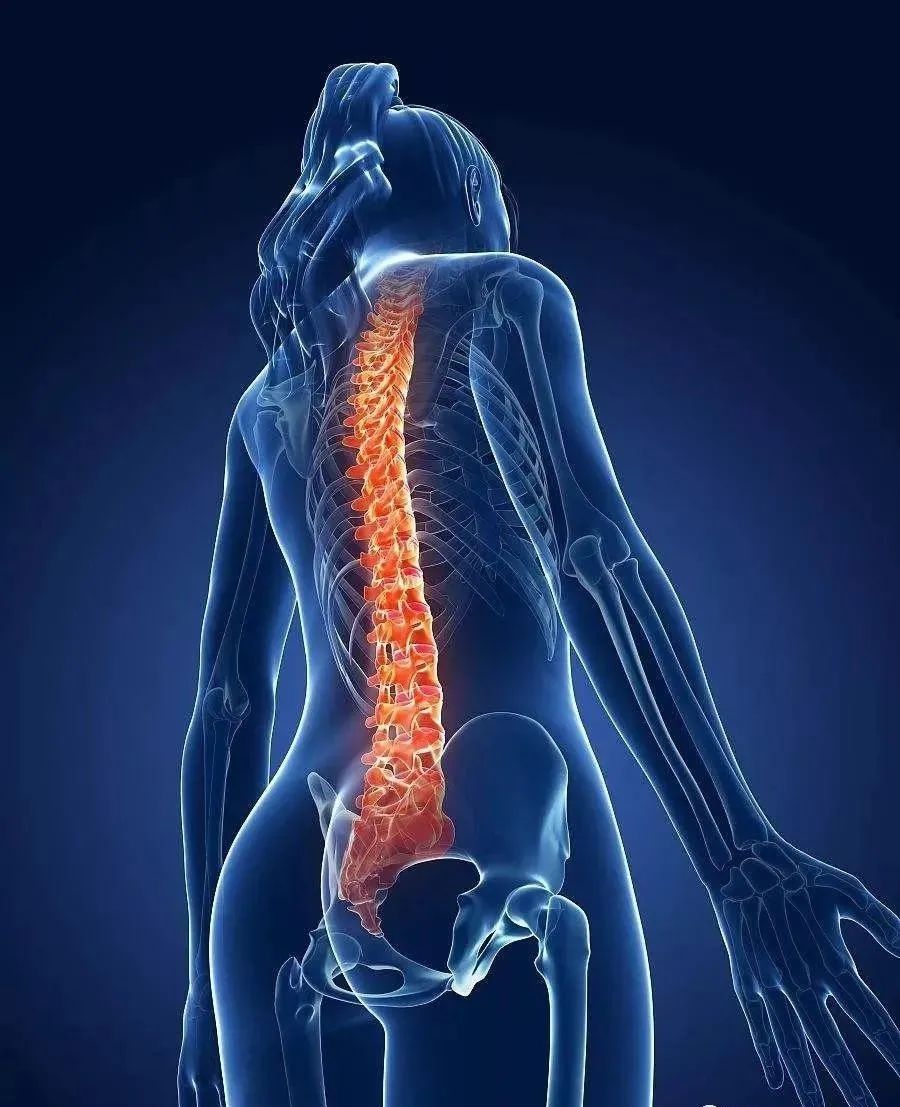
Standing crooked or sitting improperly, habitual leg crossing, and sitting in front of a computer for long periods can cause our spine to become crooked and misaligned. Once the spine bends or tilts, many problems will follow.
What diseases can poor spinal health cause?
Poor spinal health can lead to dozens of diseases, and it is not a trivial matter! Except for specific organs, the entire body is controlled by the spinal cord nerves, and once the spinal cord nervous system is compressed, it can easily lead to pathological changes.
1
Diseases caused by poor cervical spine health
Stroke, headaches, dizziness, insomnia, memory decline, shoulder and neck pain, upper limb numbness and weakness, coldness, etc.
If there are issues with our upper cervical vertebrae, misalignment can compress the vertebral artery, leading to insufficient blood supply to the brain, resulting in symptoms such as dizziness, headaches, and insomnia.
Insufficient blood supply to the brain can easily lead to stroke. Many people believe that memory decline is due to aging, but it is actually related to cervical spondylosis.
The upper cervical vertebrae are connected to the cervical plexus nerves, while the lower ones connect to the brachial plexus nerves, which control the shoulders, elbows, arms, and fingers. If there are issues with the lower cervical vertebrae, it can lead to conditions like shoulder periarthritis and frozen shoulder.
2
Diseases caused by poor lumbar spine health
Paralysis, lower back pain, lumbar muscle strain, dysmenorrhea, uterine fibroids, ovarian cysts, infertility, lumbar disc herniation, menopausal syndrome, endocrine disorders, etc.
Women should pay special attention, as the nerves in the lower lumbar region can affect the uterus, ovaries, bladder, and anus. When there are issues with the lumbar spine, it can easily lead to dysmenorrhea in young women.
TCM reminds us: infertility is also related to the lumbar spine, as the nerves in the lower lumbar region can affect the uterus and ovaries. If the uterine and ovarian functions are poor, ovulation will be problematic. For men, it mainly manifests as reduced sperm quality, leading to infertility.
3
Diseases caused by poor thoracic spine health
Chest tightness, shortness of breath, susceptibility to wind and cold, fatigue, poor digestion, and poor blood sugar control, etc.
The thoracic spinal nerves extend along our ribs to the front chest, and the muscle part can affect breast development. The internal organs from top to bottom include the heart, lungs, liver, stomach, gallbladder, and pancreas, all of which are located in the thoracic region.
Issues with the lower cervical and upper thoracic vertebrae can lead to bronchitis and colds.
Issues with the lower thoracic vertebrae can affect the pancreas, leading to poor insulin secretion and poor blood sugar control.
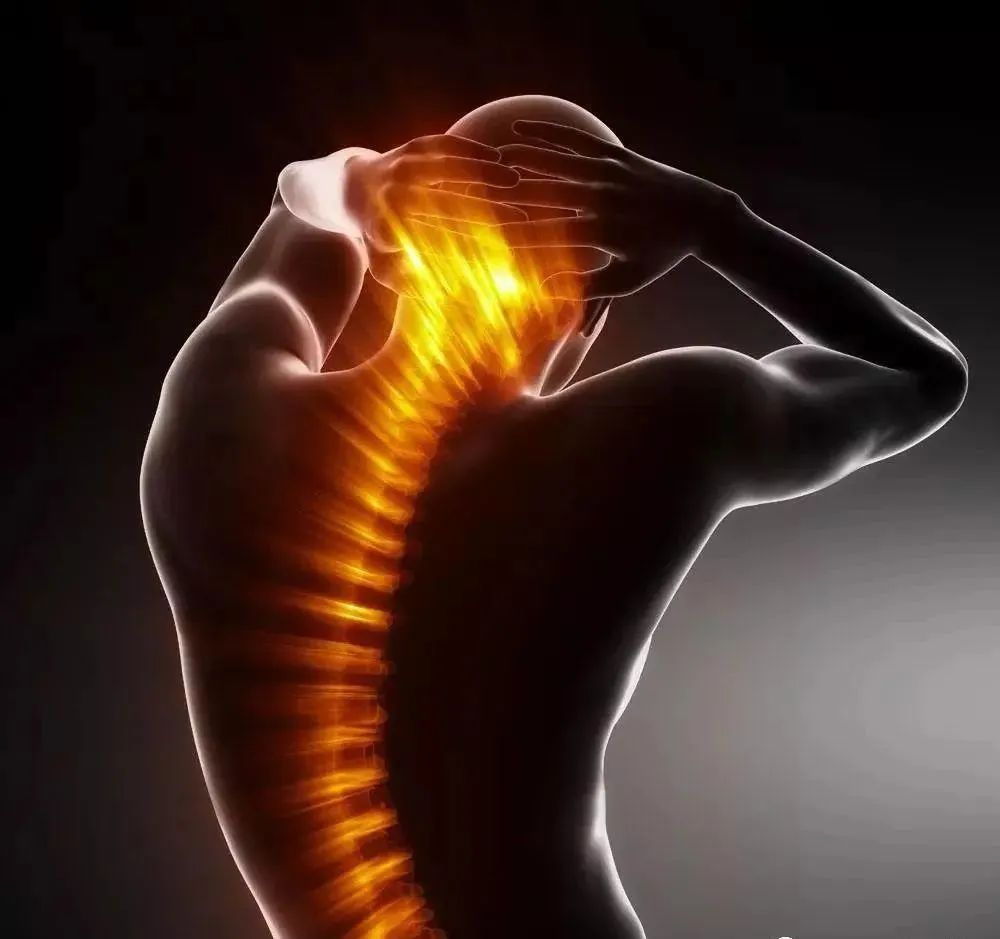
What problems can lead to spinal diseases?
Typically, the following situations are the main causes of spinal diseases:
1
Main causes of spinal diseases
1. Incorrect posture, such as sitting, standing, lying down, or working in the same position for long periods;
2. Unreasonable bedding can cause excessive tension in ligaments and muscles, leading to strain, disc herniation, and dysfunction of small joints;
3. Invasion of wind, cold, and dampness can affect local blood circulation and accelerate tissue degeneration;
4. Trauma can worsen the condition, and chronic injuries can gradually exacerbate symptoms;
5. Psychological factors and poor overall health can also lead to or worsen spinal disease symptoms;
6. Genetic factors: about 1% of patients with spinal diseases have hereditary conditions;
7. Occupational factors: dancers, long-distance drivers, welders, office workers, and those who work with their heads down for long periods.
2
What are the “killer” sitting postures?
Most spinal diseases are caused by incorrect habits or postures in daily life. Let’s take a look at the correct sitting posture:
Killer Sitting Posture: Hunchback
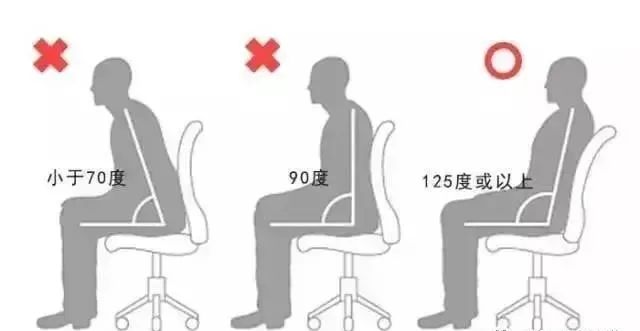
Harm: Bending greatly increases the pressure on the lumbar and cervical vertebrae.
Cause: Prolonged sitting causes stabilizing muscles to fatigue, with no support in front and a chair back behind, making it difficult to lean back, leading to posterior pelvic tilt and relaxed stabilizing muscles, causing the waist to bend. The eyes need to look straight ahead, so the head is raised, causing the cervical spine to bend.
Solution: When sitting, try to sit all the way back in the chair to increase lumbar support. Get up and move around regularly, and do more stretching exercises.
Killer Sitting Posture: Half Sitting Half Lying
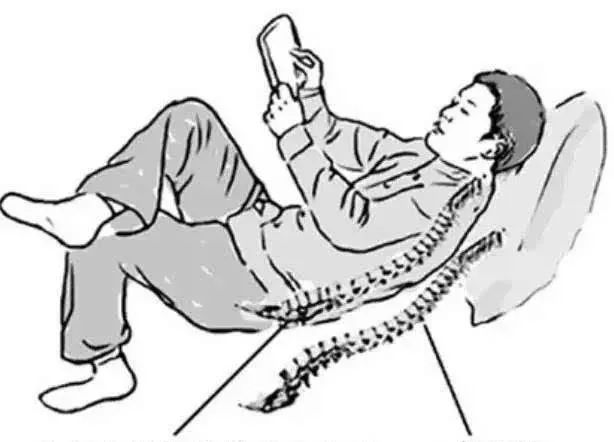
Harm: Severely compresses the lumbar intervertebral discs, obstructing the natural curvature of the spine, easily causing hunchback.
Cause: Seats like sofas are too wide, making it difficult to sit all the way back, leading to muscle fatigue without back support, causing the person to lean back for relaxation, leaving the lumbar region unsupported and placing all the pressure on the lumbar intervertebral discs.
Solution: Sit all the way back, allowing the chair back to support the lumbar spine. If unable to sit all the way back, change seats or provide lumbar support in the suspended area.
Killer Sitting Posture: Crossed Legs
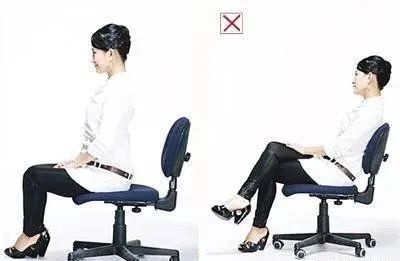
Harm: Causes pelvic tilt, lumbar lordosis, spinal scoliosis, and cervical lordosis.
Cause: Prolonged sitting with posterior pelvic tilt, when the thighs are opened for aesthetic or stability reasons, leads to further posterior pelvic tilt, lumbar lordosis, and cervical lordosis.
Solution: Sit upright.
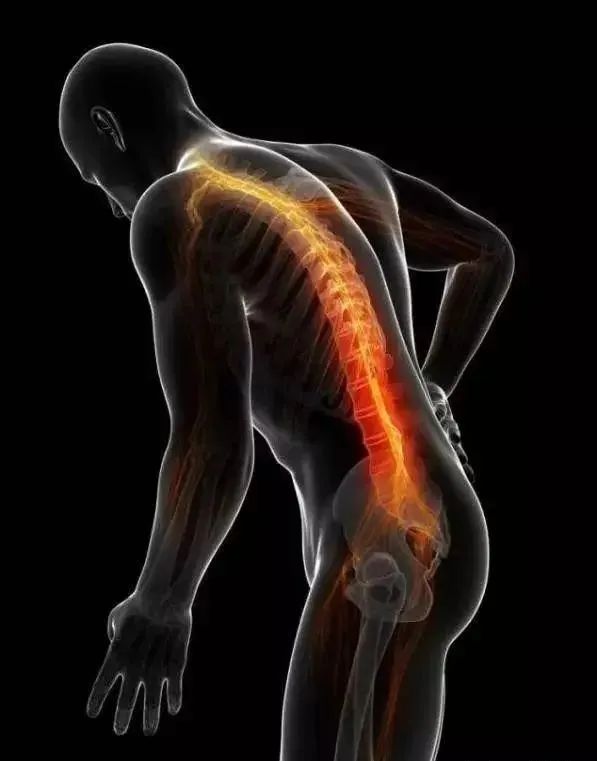
How to prevent spinal diseases?
In fact, preventing spinal diseases mainly involves changing bad lifestyle habits, exercising more, and avoiding prolonged sitting. The following rolling back movements are primarily for massaging the spine, allowing it to relax and achieve a preventive effect.
Based on individual physical conditions, those who are older or in poor health should avoid these movements.
Rolling Back Movement One
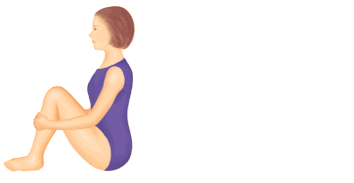
Sit on the ground with legs together and knees bent, hugging the calves with both hands, pulling in the abdomen and arching the back, rolling back from the tailbone, lumbar spine, and so on until touching the ground. Initially, the feet do not need to go over the head, and after doing it several times, depending on physical condition, roll to the thoracic and cervical spine, with toes pointing upwards, gradually getting both feet over the head and straightening them.
Rolling Back Movement Two
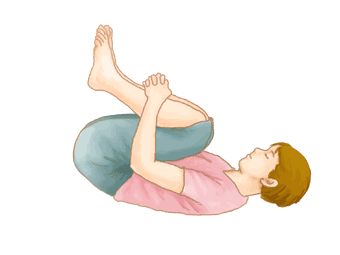
Lie on the ground with knees bent, hugging the calves with both hands, raising the head, pulling in the abdomen and arching the back, rolling back from the tailbone, lumbar spine, thoracic spine, and so on until touching the ground, rolling back and forth.
Be mindful of your physical condition, and do not force yourself if you cannot do it.

Diagnosing diseases is not difficult, but distinguishing similar cases is challenging;
Do not follow the crowd or go with the flow, as it can lead to significant errors.
Let learning become a habit!
Learn anatomy with Pao Ding! and study clinical anatomy together!
Division of the Nine Major Diagnostic and Treatment Areas of the Spine
1. Based on the surface reflection of visceral diseases
Diseases of the same name can show positive reactions (abnormal sensations) or myofascial nodules in the corresponding diagnostic areas on the back, such as lung diseases reflecting positive tenderness points in the upper thoracic region near the scapula. Liver and gallbladder diseases often reflect in the liver and gallbladder disease area, while kidney diseases often reflect in the kidney disease area.
2. Based on the anatomical position and surface projection of the same-name viscera
Each corresponding diagnostic area corresponds to the same viscera in the respective anatomical region [1]. For example, the diagnostic area related to lung and trachea diseases corresponds to lung tissue in the respective anatomical area, and its surface projection is also within that area. The reproductive disease area corresponds to the anatomical position of male and female internal reproductive organs.
3. Based on the distribution characteristics of visceral nerves and spinal nerves
The diagnostic area related to the brain corresponds to the anatomical region of the medulla oblongata, while the area related to cervical sympathetic diseases corresponds to the sympathetic ganglia, such as the stellate ganglion.
4. Based on the traditional acupoint distribution of visceral diseases
Traditional Chinese medicine believes that the midline of the spine is the Du Meridian, which is the sea of Yang meridians, governing the Yang energy of the entire body. “Treating along the Du Meridian” is a saying from the “Secret Transmission of Hua Tuo, the Divine Physician,” as the Du Meridian is fundamental to the twelve meridians. Therefore, diseases of the twelve meridians, five viscera, six bowels, and all limbs can be treated along the Du Meridian.
Specific Division of the Nine Major Diagnostic and Treatment Areas of the Spine
1. Diagnostic Area for Brain Diseases
From the upper edge of the external occipital protuberance to the upper edge of the bilateral temporal mastoid bones, forming an arc-shaped line, connecting the lower edge of C3 spinous process, forming an inverted triangle, this area is related to brain nerve diseases.

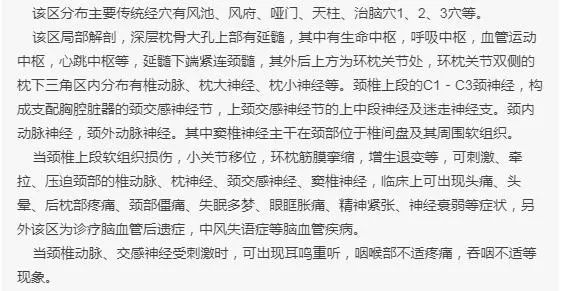
2. Diagnostic Area for Sympathetic Diseases
Between the upper edge of C4 spinous process and the lower edge of C7 spinous process, extending about 6 cm outward to the outer edge of the erector spinae muscle, forming an equilateral triangular area, mainly used for diagnosing and treating cervical sympathetic nerve-related diseases and diseases of the neck, shoulder, arm, and hand (between C6-C7 spinous processes).
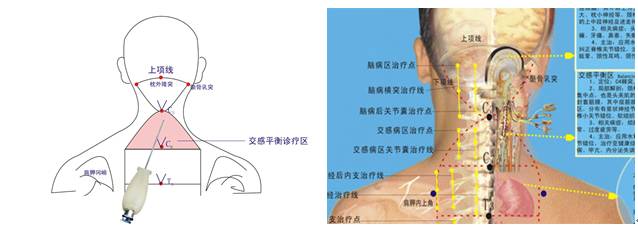
This area mainly includes traditional acupoints such as Dazhui, cervical spine, and pressure points for lowering blood pressure and blood sugar.
The middle and lower segments of the cervical spine are the most mobile parts of the neck and are also the most easily damaged. The spinal nerves from C5 to C7 form the brachial plexus. The preganglionic fibers of the cervical sympathetic ganglia originate from the lateral horn of the thoracic spinal cord. At the same time, on the lateral side of the C6-C7 vertebrae, corresponding to the cricoid cartilage of the larynx, there is an irregularly shaped stellate ganglion, which in adults is about 4.5 cm long, 0.5 cm wide, and 0.3 cm thick, composed of preganglionic and postganglionic fibers. The anterior side is the common carotid artery, internal jugular vein, vagus nerve, recurrent laryngeal nerve, and cervical vein, while the anterior side is the anterior scalene muscle and loose connective tissue, with the lower part being the apex of the pleura.
When there are soft tissue injuries, small joint disorders, degenerative changes, or adhesions in the lower cervical spine, it can stimulate the posterior branches of the spinal nerves, cervical sympathetic nerves, stellate ganglion nerves, and vagus nerves, leading to a series of sympathetic nervous system dysfunction syndromes, such as anxiety syndrome, chronic fatigue syndrome, neurotic heart syndrome, and endocrine dysfunction, manifesting as dizziness, insomnia, palpitations, vivid dreams, anxiety, etc. At the same time, using water needle knife therapy around the C7 spinous process can treat hypertension, diabetes, hyperthyroidism, and endocrine diseases.
3. Diagnostic Area for Lung Diseases
From the lower edge of the C7 spinous process to the lower edge of the T3 spinous process, extending about 6 cm outward to the outer edge of the erector spinae muscle, forming a rectangular area, this area is related to lung and trachea diseases. Traditional medicine believes that the lungs are the most important organ among the five viscera and six bowels, governing respiration and the white meridian, and anatomically, the lungs are indeed located above the viscera.
 This area mainly includes traditional acupoints such as Jiaji, Bailao, Dazhui, Taodao, Dingchuan, and Fengmen, with the sympathetic nerves controlling the lungs and trachea located in the spinal cord segments T2-T6; the lower center of the sympathetic nervous system is located in the spinal cord segments C7-T3, and the paravertebral sympathetic ganglia are located beside the spinal nerves.
This area mainly includes traditional acupoints such as Jiaji, Bailao, Dazhui, Taodao, Dingchuan, and Fengmen, with the sympathetic nerves controlling the lungs and trachea located in the spinal cord segments T2-T6; the lower center of the sympathetic nervous system is located in the spinal cord segments C7-T3, and the paravertebral sympathetic ganglia are located beside the spinal nerves.
When there are soft tissue injuries, small joint dislocations, or degenerative changes in the lower cervical and upper thoracic spine, it can lead to positive pathological reactions in this area (stimulation of the posterior branches of the spinal nerves and paravertebral sympathetic ganglia), clinically manifesting as symptoms such as chest tightness, shortness of breath, cough, and difficulty breathing.
4. Diagnostic Area for Heart Diseases
From the lower edge of the T3 spinous process to the lower edge of the T6 spinous process, extending about 6 cm outward to the outer edge of the erector spinae muscle, forming a rectangular area, this area is the diagnostic area for heart diseases.
Heart-related diseases do not only refer to organic lesions of the heart itself but also refer to the surface reaction area of the heart on the back, where the sympathetic and vagus nerves undergo pathological changes, leading to autonomic nervous dysfunction, manifesting as neurotic heart syndrome, functional heart rhythm disorders, and other symptoms.
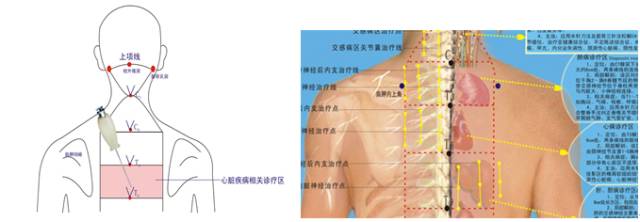
This area mainly includes traditional acupoints such as Jiaji, Shenzhu, Xinshu, Jueyinshu, Dushu, Shendao, Lingtai, Gaohuang, Shentang, and Xuanxi.
When there are soft tissue injuries, small joint dislocations, or degenerative changes in the middle and upper thoracic spine, it can lead to positive pathological reactions in this area (stimulation of the posterior branches of the spinal nerves and paravertebral sympathetic ganglia), resulting in autonomic nervous dysfunction, manifesting as palpitations, chest tightness, functional heart rhythm disorders, irritability, and chest tightness.
5. Diagnostic Area for Liver and Gallbladder Diseases
From the lower edge of the T6 spinous process to the lower edge of the T9 spinous process, extending about 6 cm outward to the outer edge of the erector spinae muscle, this area is related to liver and gallbladder diseases.

This area corresponds to the anatomical position of the liver and gallbladder, with the sympathetic nerves controlling the liver and gallbladder originating from the dorsal roots of the 7th, 8th, and 9th thoracic spinal segments, reflecting liver and gallbladder diseases in the right side of the T6-9 transverse processes and the area below the right scapula.
Discomfort in the liver and gallbladder area can cause abdominal distension, nausea, vomiting, loss of appetite, and pain in the right rib and right scapula area.
6. Diagnostic Area for Stomach Diseases
From the lower edge of the T9 spinous process to the lower edge of the T12 spinous process, extending about 6 cm outward to the outer edge of the erector spinae muscle, this area is related to spleen and stomach diseases.
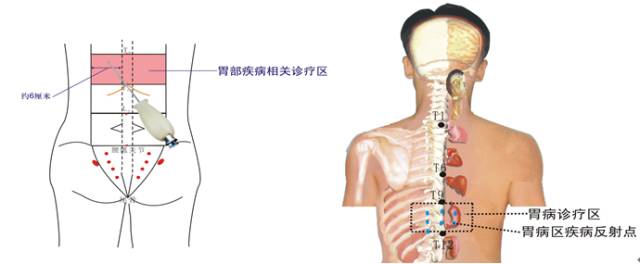
This area mainly includes traditional acupoints such as Ge Yu, Yi Yu (below the stomach), Gan Yu, Dan Yu, Pi Yu, Wei Yu, Jiaji, Zhi Yang, Jin Suo, Zhong Zhu, Ge Guan, Hun Men, Yang Gang, Yi She, Wei Cang, etc.
The spleen and stomach are located in the middle region, and the anatomical position of the viscera corresponds to the positive points on the surface. Liver and gallbladder diseases reflect on the right side of the T6-10 transverse processes, while stomach and duodenal diseases reflect on the left side near the T9-12 transverse processes, and pancreatic diseases reflect in the lower right side of the thorax, corresponding to the projection area of the pancreas.
When there are soft tissue injuries, small joint dislocations, or degenerative changes in the lower thoracic spine, it can lead to stimulation and pulling of the visceral nerves, leading to digestive system symptoms such as upper abdominal distension, acid reflux, loss of appetite, stomach pain, nausea, and vomiting.
7. Diagnostic Area for Kidney Diseases
From the lower edge of the T12 spinous process to the upper edge of the L3 spinous process, extending about 6 cm outward to the outer edge of the erector spinae muscle, this area corresponds to the kidney’s surface projection.
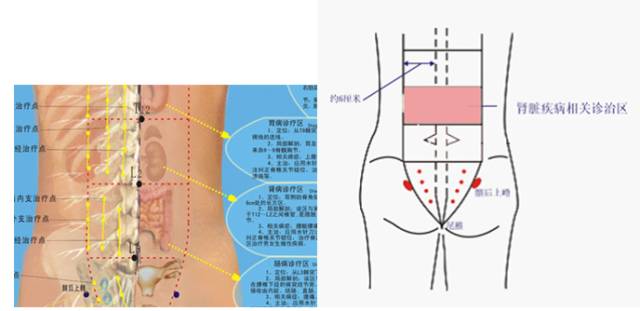
This area mainly includes traditional acupoints such as San Jiao Yu, Shen Yu, Qi Hai Yu, Xuan Shu, Ming Men, Xia Ji Yu, Huang Men, Zhi Shi, etc.
When there are soft tissue injuries, small joint dislocations, or degenerative changes in the lower thoracic and upper lumbar spine, it can lead to positive nodular tenderness reactions in the kidney disease area. Clinically, symptoms such as kidney and ureteral pain, abnormal urination, urgency, and frequency may occur.
8. Diagnostic Area for Intestinal Diseases
From the lower edge of the L3 spinous process to the lower edge of the L5 spinous process, extending about 6 cm outward to the outer edge of the erector spinae muscle, this area is related to intestinal diseases.
This area mainly includes traditional acupoints such as Qi Hai, Da Chang Yu, and Yao Yang Guan.
This area corresponds to the surface projection of the large intestine. When intestinal diseases occur, they can reflect on the lower back, near the transverse process nodules of the lower lumbar spine, where the sympathetic ganglia of the L1-L3 segments form the visceral nerve plexus, receiving information from the visceral, colon, bladder, and other organs.
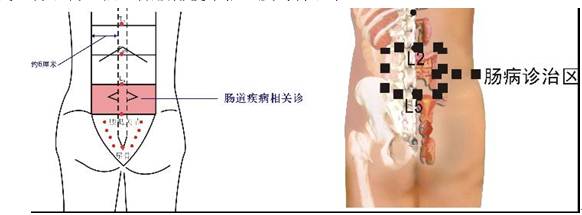
When there are soft tissue injuries, lower lumbar injuries, small joint dislocations, or degenerative changes, it can lead to abdominal pain, diarrhea, constipation, lower abdominal distension, and even obstruction; this area is also a common site for lumbar disc herniation and is an important area for treating lumbar pain, lumbar three transverse process syndrome, lumbar muscle strain, and lumbar spinal canal stenosis.
9. Diagnostic Area for Reproductive and Urinary Diseases
From the lower edge of the L5 spinous process, connecting the upper ends of the bilateral sacroiliac joints to the tailbone, forming an inverted triangular area. This area contains four pairs of sacral foramina, with the anterior branches of the sacral nerves emerging from the four pairs of anterior foramina, innervating pelvic organs such as the uterus, appendages, and male internal reproductive organs; the posterior branches of the sacral nerves emerge from the four pairs of posterior foramina, innervating the posterior part of the sacrum and tailbone. The lateral horns of the sacral vertebrae S2-S4 contain the lower centers of the parasympathetic nervous system.
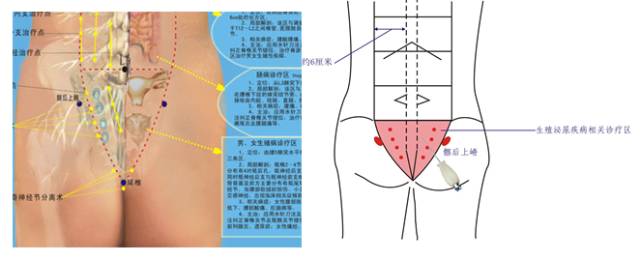
This area includes traditional acupoints such as Ba Liao, Shi Qi, Guan Yuan Yu, Bladder Yu, Small Intestine Yu, Waist Yu, and Waist Qi.
When there are injuries to the lumbar and sacral regions, soft tissue injuries, sacroiliac joint dislocations, or degenerative changes, it can lead to reproductive system diseases such as male impotence, decreased libido, and lumbar-sacral distension, while females may experience dysmenorrhea, amenorrhea, functional infertility, pelvic inflammatory disease, and urinary and bowel disorders.
Division of the Nine Major Systems of Disease Corresponding to the Chest and Abdomen
The nine major systems of diseases corresponding to the spinal region have corresponding diagnostic areas in the head, chest, and abdomen.
1. Corresponding Diagnostic Area for Brain Diseases
Located in the cap-like area of the scalp, the area around Baihui acupoint and the surrounding four Shencong points, within a 6 cm radius, is known as the Baihui Shencong area, which corresponds to the diagnostic area for brain diseases, mainly used for diagnosing and treating brain diseases and related conditions, serving as the acupuncture point and the point for fascial separation.
2. Corresponding Diagnostic Area for Sympathetic Diseases
Located in the anterior cervical fascia area, the sympathetic disease area corresponds to the level of the Adam’s apple, the anterior edge of the sternocleidomastoid muscle, and the level of the sternoclavicular joint, forming an inverted triangular area, which serves as the acupuncture point.
3. Corresponding Diagnostic Area for Lung Diseases
Located in the upper middle section of the anterior chest fascia, the area formed by the level of the sternoclavicular joint and the line connecting the two nipples, serving as the acupuncture point and the point for fascial separation.
4. Corresponding Diagnostic Area for Heart Diseases
Located in the lower middle section of the abdominal fascia, the area between the midpoint of the line connecting the two nipples and the area at the base of the xiphoid process, serving as the acupuncture point and the point for fascial separation.
5. Corresponding Diagnostic Area for Liver and Gallbladder Diseases
Located in the lower edge of the right rib fascia area, the area from the tip of the right rib arch to the upper and lower 6 cm area of the xiphoid process, with the midpoint of the right rib arch as the treatment point, serving as the acupuncture point and the point for fascial separation.
6. Corresponding Diagnostic Area for Stomach Diseases
Located in the upper middle section of the abdominal fascia, the area between the base of the xiphoid process and the navel, extending outward to the outer edge of the rectus abdominis tendon sheath, serving as the acupuncture point and the point for fascial separation.
7. Corresponding Diagnostic Area for Kidney and Ureter Diseases
Located in the external abdominal fascia area, the area above the inguinal canal, usually reflecting the area where kidney and ureter diseases occur, serving as the acupuncture point and the point for fascial separation.
8. Corresponding Diagnostic Area for Intestinal Diseases
Located in the external abdominal fascia area, the area between the navel and the upper anterior superior iliac spine, serving as the acupuncture point and the point for fascial separation.
Discussion on the Distribution of Traditional Meridians and Nerves in the Back
1. Low-level Central Treatment Line
The low-level central treatment line is located along the midline of the spinous processes, with the deep part being the spinal canal that runs through the spine, and the outer line being the projection line of the spinal nerve distribution, hence the name low-level central treatment line; this line corresponds to the Du Meridian, which runs from the intervertebral joint (Fengfu acupoint) to the Changqiang acupoint at the tailbone, traversing the entire spinal cord, serving as the segment for the visceral nerve low-level center. The 22-23 pairs of paravertebral sympathetic ganglia are located on both sides of the spine, adjacent to the transverse processes, including three cervical segments, eleven thoracic segments, four lumbar segments, and four sacral segments, each being an independent unit. Additionally, thirty-one pairs of spinal nerves emerge from the lateral horn of the spinal cord, connecting with the sympathetic ganglia through communicating branches. The traditional acupoint line of the Du Meridian is the main pathway for acupuncture treatment of visceral diseases. Historical practitioners believed that the Du Meridian is the sea of Yang meridians, governing the original energy of the body, and diseases of the twelve meridians, five viscera, six bowels, and all limbs can be treated along the Du Meridian.
2. Visceral Nerve Treatment Line
The visceral nerve treatment line is located along the inner edge of the facet joints, with the deep part being the paravertebral sympathetic ganglia line, hence the name visceral nerve treatment line; this corresponds to the traditional acupoint line of the Hua Tuo Jiaji points, symmetrically located on both sides. This line is the intersection of the posterior sides of the spinal cord and the paravertebral sympathetic ganglia, and treatment along this line can regulate the autonomic nervous function of the viscera.
3. Medial Branch of the Spinal Nerve Treatment Line
The medial branch of the spinal nerve is located along the outer edge of the facet joints, with the deep part being the medial branch of the posterior spinal nerves; this line corresponds to the inner line of the Bladder Meridian in traditional meridian theory. This line serves as the communication route between the spinal nerve roots and the sympathetic nerves, with the central line as the axis, symmetrically located on both sides. Treatment along this line can address visceral diseases.
4. Lateral Branch of the Spinal Nerve Treatment Line
The lateral branch of the spinal nerve corresponds to the outer edge of the erector spinae muscle, with the deep part being the lateral branch of the posterior spinal nerves. This line corresponds to the outer line of the Bladder Meridian in traditional meridian theory, located along the outer edge of the erector spinae muscle, with one on each side. According to the nine major divisions, this line belongs to the outer line of the nine major areas, and treatment along this line can also address visceral diseases.
Four-Step Positioning Diagnosis Method and Diagnostic Standards for Spinal-Related Diseases
The diagnostic level for spinal-related diseases has improved with in-depth exploration of the pathogenesis. Spinal instability has become a characteristic of spinal-related diseases, making them prone to occurrence and gradual damage. The entire body’s nerves transmit signals through the spinal canal; the low-level centers of the sympathetic nervous system are located in the lateral horns of the thoracic spinal cord, with preganglionic fibers reaching various sympathetic ganglia through the intervertebral foramina, distributing to various viscera and organs. The blood supply to the brain is delivered by the vertebral arteries and internal carotid arteries. Therefore, diagnosing spinal-related diseases is relatively complex, but it also has certain regularities. Many treatments for spinal-related diseases are ineffective due to unclear diagnoses, highlighting the importance of accurate diagnosis. Practitioners should make preliminary diagnoses based on the patient’s medical history, clinical symptoms, and signs, but a definitive diagnosis still relies on systematic and precise clinical examinations. This chapter will separately discuss the common diagnostic points and auxiliary diagnoses for spinal-related diseases.
1. Positioning Diagnosis Method
1. First Step: Neural Positioning Diagnosis Method During the consultation, analyze the patient’s pain and numbness locations according to the nine major diagnostic areas and corresponding areas, determining the location of the compressed nerve roots and preliminarily identifying the misaligned vertebrae or joints.
2. Second Step: Observation Positioning Method Observe the shape of the spine, checking for any deviations in the midline, whether the left and right scapulae are at the same height, whether the left and right ribs are parallel, whether the left and right iliac crests are equal in height, whether the gluteal cleft and midline are aligned, and whether there are any changes in skin color or pigmentation in the spinal area.
3. Third Step: Palpation Positioning Method Use the three-finger palpation method to determine if the spinous processes are misaligned, if there are any audible friction sounds or clicks in the facet joints, and if there is tenderness or positive reactions such as hard nodules, cord-like swellings, or compensatory hypertrophy in the transverse processes.
Through the three steps of palpation, if the first and second positioning diagnoses are confirmed, the diagnosis of vertebral misalignment can be further clarified.
4. Fourth Step: Spinal Imaging Positioning Method Carefully observe the changes in the intervertebral joints on lateral X-ray films, changes in spinal dynamics, whether the physiological curvature has straightened, whether there is lordosis or scoliosis, whether the posterior edges of the vertebrae have sharpened, and whether there is bone bridge formation; changes or dislocations in the shapes of the intervertebral joints also indicate vertebral misalignment. Degenerative changes in intervertebral discs, bone hyperplasia in vertebral joints, and calcification of ligaments should be analyzed in conjunction with the previous three positioning diagnoses to arrive at a final positioning diagnosis conclusion. Attention should be paid to exclude fractures, dislocations, tumors, tuberculosis, eosinophilic granuloma, and purulent inflammation in spinal disease patients.
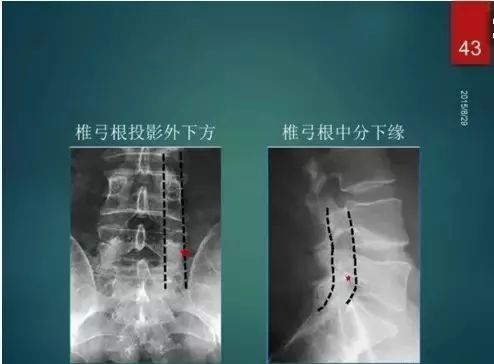
2. Diagnostic Standards
The diagnosis of spinal-related diseases is based on the following eight criteria:
1. Presence of one or more clinical symptoms;
2. Functional activity range of the affected spinal segment (cervical, thoracic, lumbar, sacral), especially rotation, has certain limitations or pain;
3. Dynamic and static palpation of the three spinous lines: a. Spinous processes may be misaligned; b. Facet joints may be disordered; c. Transverse processes may have nodules. If there are any abnormal changes in soft tissues, such as:
(1) Spinous processes show significant misalignment or convexity/concavity, and tenderness may be present on one side of the affected vertebra or on the spinous process;
(2) Ligaments, muscles, and attachment points related to the affected vertebra may have palpable nodules, cords, or other positive reactions;
4. X-ray findings that indicate damage to the spine, such as spinal misalignment, forward or backward tilting, or dislocation of intervertebral joints;
5. At least one auxiliary examination supports the diagnosis of spinal-related diseases;
6. Specialized examinations exclude organic lesions of related organs causing symptoms;
7. Exclude spinal fractures, dislocations, tumors, tuberculosis, eosinophilic granuloma, and purulent inflammation in spinal disease patients;
8. Laboratory tests within normal ranges.

A good method or technique must stem from solid theoretical knowledge.
Remember to follow us and learn together!
More
Knowledge
Awaits
To be Discovered
Follow us for more free and exciting articles every day!
